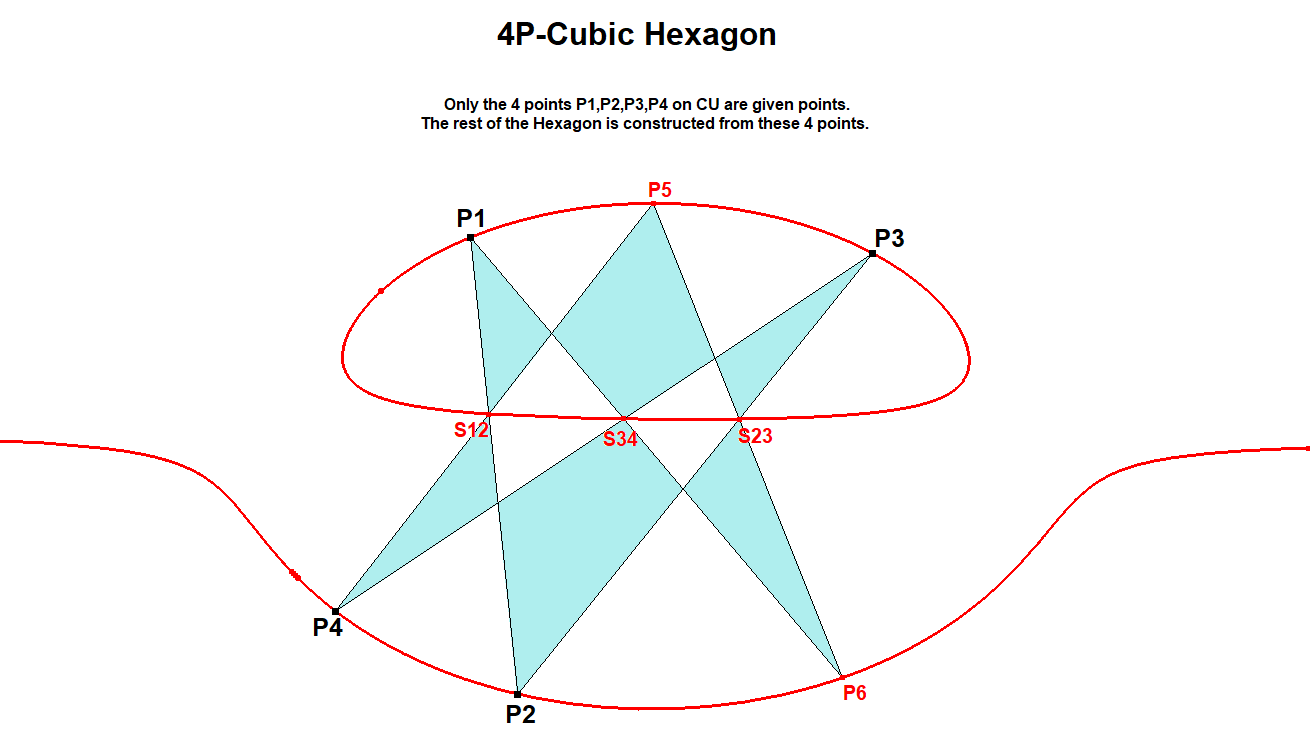CU-4P-cHe1 CU-inscribed Complete Hexagon
Definitions
Definition 1: A hexagon, or 6-gon, is a geometrical figure consisting of 6 consecutive vertices, with no three of them being collinear.
Definition 2: A complete hexagon is a geometric figure formed by 6 consecutive vertices, with no three of them being collinear. In addition, it includes the points of intersection of the 3 pairs of opposite sides.
In other words, a complete hexagon comprises 6 consecutive vertices and the points of intersection of the 3 pairs of opposite sides, forming a total of 9 distinct points.
Theorem: A complete hexagon can be inscribed in a cubic curve using only four initial points.

Construction
The procedure to construct the CU-inscribed Hexagon (6-gon) using 4 random points on CU is:
- Start with 4 random points P1,P2,P3,P4 on a reference cubic CU.
- Draw line P1P2 intersecting CU again in S12.
- Draw line P2P3 intersecting CU again in S23,
- Draw line P3P4 intersecting CU again in S34,
- Draw line P4S12 intersecting CU again in P5,
- Draw line P5S23 intersecting CU again in P6.
- Draw line P6S34 intersecting CU again in P1 !
Last step easily can be proven using the CU Point Addition Method CU-4:
CU Point Validation
- Use the property that for 3 collinear points P, Q, and R, the sum P + Q + R = N.
- S12 = N – P1 – P2
- S23 = N – P2 – P3
- S34 = N – P3 – P4
- P5 = N – P4 – S12 = N – P4 – (N – P1 – P2) = P1 + P2 – P4
- P6 = N – P5 – S23 = N – P5 – (N – P2 – P3) = P2 + P3 – P5
- Px = N – P6 – S34 = N – (P2 + P3 – P5) – (N – P3 – P4) = -P2 + P4 + P5 = -P2 + P4 + (P1 +P2 – P4) = P1
Connection with Eckart’s Hexagon Theorem
Eckart’s Hexagon Theorem (QPG#1799) states that given 3 collinear points P,Q,R and a starting point X1, then a closed Hexagon can be constructed. The 6 vertices will be coconic.
The way of construction of the Hexagon is similar to the construction of the CU-4P-Hexagon, only the starting points are different, there are 3 collinear points and 1 other point.
Applications
- The 3 Quasi-Miquel Triangles (CU-IP-3P1) form together a CU-inscribed Complete Hexagon.
- The 9P-SumPoints and surrounding points form a CU-inscribed Complete Hexagon. See CU-9P-P1.
Estimated human page views: 4
